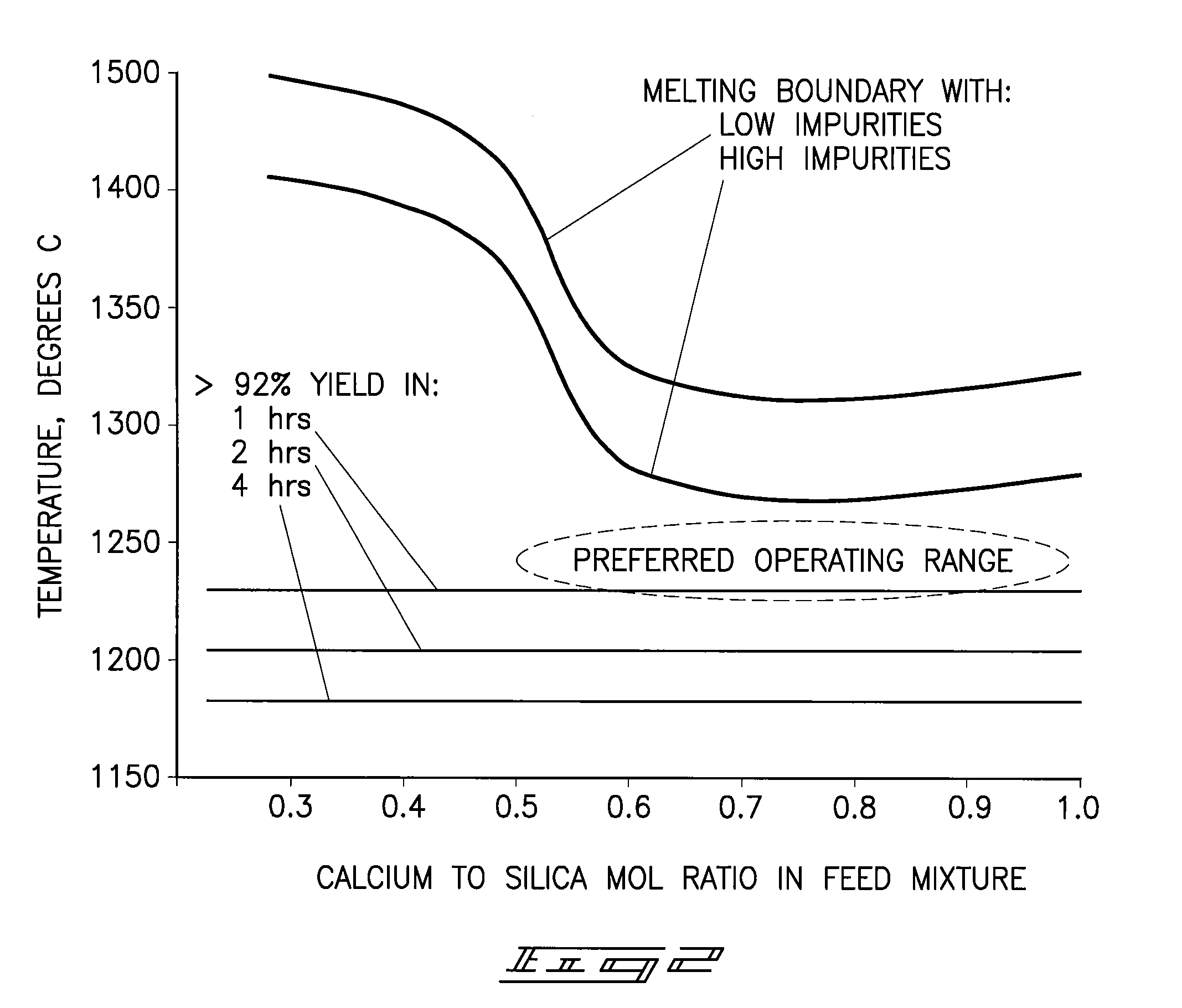Phosphorous pentoxide producing methods
a technology of phosphorous pentoxide and production methods, applied in the field of methods, can solve the problems of electricity cost, inapplicability, and inability to meet the needs of phosphorus pentoxide production,
- Summary
- Abstract
- Description
- Claims
- Application Information
AI Technical Summary
Benefits of technology
Problems solved by technology
Method used
Image
Examples
example 1
[0092]Raw phosphate ore from the Meade formation near Soda Springs, Id. was combined with raw silica ore from a mine near Soda Springs, Id. and delayed green petroleum coke from a gulf coast petroleum refinery such that the calcium-to-silica mole ratio was 0.56 and the fixed carbon in the petroleum coke was 1.3 times the theoretical to reduce the phosphate in the mixture. The mixture contained 13.43 wt % P2O5, 21.33 wt % CaO, 42.42 wt % SiO2, and 7.38 wt % fixed carbon on a dry basis. The mixture was dried and then ground to 80.2%-200 mesh in an open circuit ball mill. Twelve percent water was added to the ground mixture and formed in a die into several ½ inch diameter pellets which were then dried in an oven at 280° F. One pellet was placed in a graphite crucible with a graphite lid and the crucible and its contents heated at 20° C. / min to 1180° C. and held for one hour under an atmosphere of nitrogen. After cooling the crucible to room temperature the pellet was analyzed to determ...
example 2
[0094]Several of the spent pellets from Example 1 were analyzed and compared to the analyses of the feed pellets to determine the fate of impurities in the feed compositions. The elements that volatilized either partially or totally from the pellet during the phosphate reduction together with the weight fraction of the element in the feed pellet, were Ag (<1 ppm), As (10.2 ppm), C (8.2%), Cd (33 ppm), Cl (90 ppm), Cs (1.3 ppm), F (1.27%), Ga (3 ppm), Hg (0.22 ppm), K (0.44%), N (0.13%), Na (0.25%), P (6.55%), Pb (7 ppm), Rb (18 ppm), S (0.73%), Se (6.8 ppm), Tl (1 ppm), and Zn (688 ppm). The elements which were present in significant amounts, which were of concern, and which evolved from the feed pellets were K, Na, S, and F. FIG. 3 shows the weight fraction of these elements which volatilized from the pellet over a range of hold temperatures as compared to the weight of the elements in the feed agglomerates. The composition of the pellets tested in this volatilization study is the ...
example 3
[0096]The co-ground ore / silica / green petroleum coke mixture indicated in EXAMPLE 1 above was blended with 9 wt % moisture and formed into +¼ / −½ inch balls on a 3 foot balling pan with an additional 3 wt % moisture added through control sprays on the balling pan. The balls were dried in a tray drier, and a twenty pound charge of balls was processed in a 13.5 inch diameter by 22¼ inch long batch rotary kiln at 1320° C. The kiln was fired with 1 to 2 feet3 / minute (cfm) of propane, about 44 cfm of air, and 0 to 2 cfm of oxygen as necessary to hold the temperature at the set point. The kiln was fitted with an onboard thermocouple and had zircon refractories.
[0097]The kiln was preheated to 1189° C. and twenty pounds of balls were charged to the batch kiln with a scoop. Samples of the kiln solids were sampled every fifteen minutes and analyzed to determine the burnout of carbon and the extent of phosphate reduction. The surface of the kiln bed reached 1271° C. by the minute sample, oversho...
PUM
| Property | Measurement | Unit |
|---|---|---|
| mole ratio | aaaaa | aaaaa |
| bed temperature | aaaaa | aaaaa |
| bed temperature | aaaaa | aaaaa |
Abstract
Description
Claims
Application Information
 Login to View More
Login to View More - R&D
- Intellectual Property
- Life Sciences
- Materials
- Tech Scout
- Unparalleled Data Quality
- Higher Quality Content
- 60% Fewer Hallucinations
Browse by: Latest US Patents, China's latest patents, Technical Efficacy Thesaurus, Application Domain, Technology Topic, Popular Technical Reports.
© 2025 PatSnap. All rights reserved.Legal|Privacy policy|Modern Slavery Act Transparency Statement|Sitemap|About US| Contact US: help@patsnap.com



